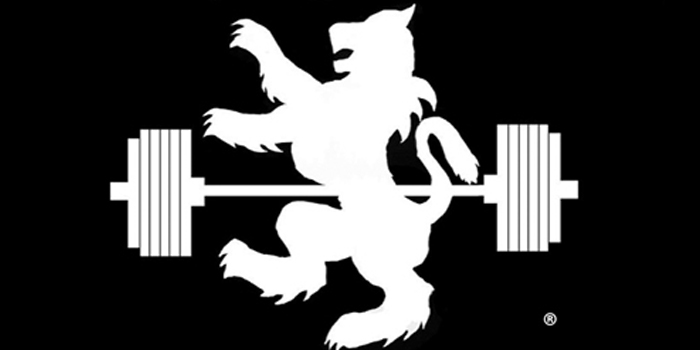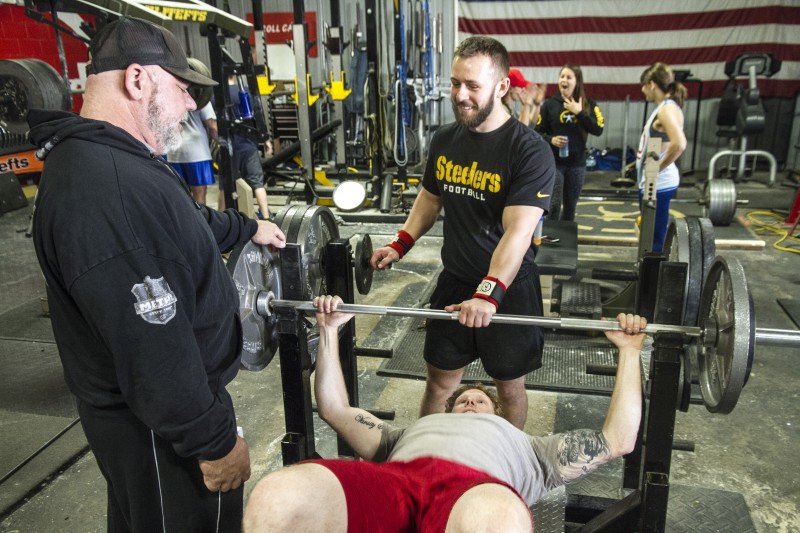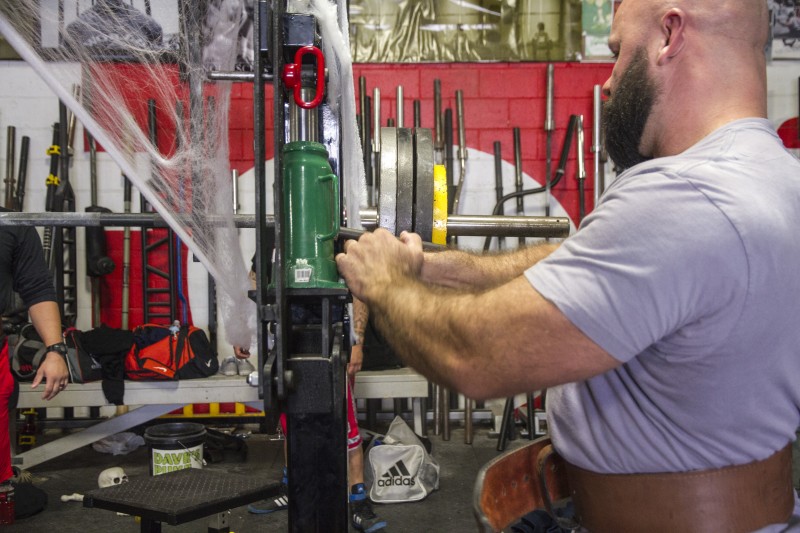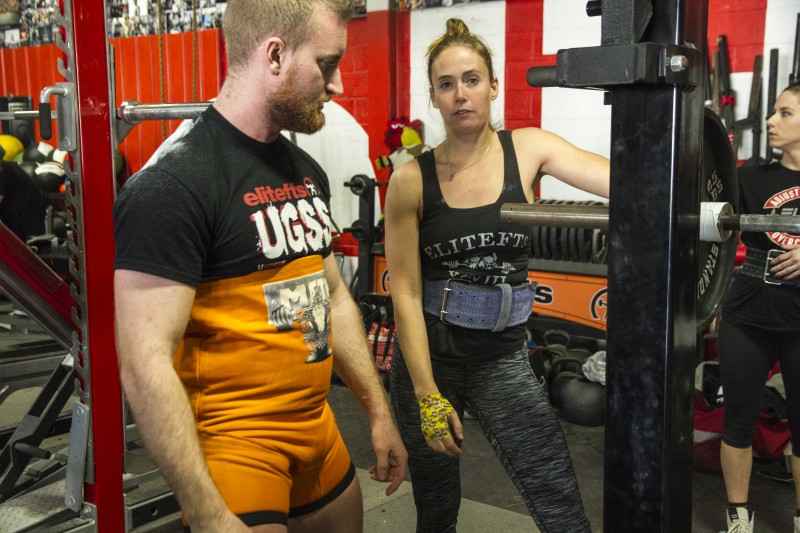
The Pitcher and White Board Programming
I'm a neutral-grip-chin-up-kind-of-guy, which is to say, I'd be lost without the monkey chin bar on my Collegiate Power Racks. I typically try to add additional volume by reducing the reps on early sets so I don't burnout too early (i.e., instead of doing ten reps after warming up, I'll leave several reps in the tank and wait for several sets down the road, after I’ve reached the desired volume, to amplify the intensity).
Most recently, I've added a super-slow concentric and eccentric rep (or two), implementing static holds at various positions. I imagine I'm pulling (arm wrestling) against Devon Larratt and he can't pin me — he’s sure as hell trying.
Last week, The Pitcher, home from college for a few of weeks, joined me in the garage gym for his evening training session. It was comfortably warm; an atypical May evening in Texas. I was completing my training with some specific grip work as the finisher. Between sets, I sat on an adjustable box squat box in the driveway and watched The Pitcher perform sumo deadlifts with textbook form, snapping his hips as sweat fell from my nose.
He finished the set, dropping the bar to the rubber horse-stall-mats with a thud. With a look of disdain, he peered over to the large white board we have screwed to the wall in the gym. He appeared dejected and his shoulders slumped, if only for a moment.

"It's times like this I hate that I've written my entire workout on that white board," he said.
"Why? Because now you feel obligated to complete the entire program and you're only one-third of the way through?"
"Exactly," he said.
“How do you feel? Good?” I asked.
“I feel good.”
“Unfortunately, we all have to put in the work to get what we want,” I said. “There are no shortcuts, at least not over the long term. If you feel good, stay the course.”
“I know,” The Pitcher responded, bemoaning his near-term fate.
Heavy is the head trying to add velocity to a fastball from the left side.
Lesson 1: When possible, fully program before the training session.
Training Athletes (Clients) — Progressions
I always feel anxious before training someone — constantly second-guessing myself, fretting over my preparation.
Why so serious? (As the Joker would ask.)
I guess the angst is a result of how seriously I take the work. I want to provide value, and I'm fastidious in attempting to gear the programming toward successfully achieving my trainee’s desired goal, which is why I stress, probably needlessly when things get off-track.
Debbie walks into my gym for the first time with a big, but awkward smile. She’s ready to go but doesn’t quite know what to expect. She’s still feeling me out.
We re-discuss her goals and her health. She reveals her knees get angry from time to time. The pain occurs principally when she is kneeling with her weight on them (we subsequently learn she can squat pain-free when she sits back, keeping her knees from drifting past her toes — using proper form).
I have a laundry list of movements I want to watch her perform after we warm up. My intention is to complete a baseline assessment of how she moves and get a sense of her strength level.
She is excited by the prospect of weight training and has spent a lot of time on Instagram, following women who are fond of posting before and after pictures, as well as those who photographically document their entire body transformation journeys. Admittedly, I'm a voyeur too. I can see where she is coming from, and some of the transformations I've seen are pretty impressive.
"Debbie, you have to remember, these changes took place over very long periods of time. These women put in a lot of hours, grinding, and hard work to build a strength foundation."
Viewing on Instagram somehow, in my opinion, sanitizes some of the processes; it's hard to fully appreciate the forced adaptation—the incredible amount of work—that is paramount to the process, through a bunch of pictures and brief videos. Debbie says she understands, but I can see she has visions of squatting with a heavy barbell draped across her soft shoulders.
During the warm-up, I quickly realize we are months away from any significant barbell work and I'm going to need to program a large amount of bodyweight work that is necessary but won't feel quite as glamorous to my young Instagrammer.
When I first began training athletes, I used to worry about adding additional variety to make the sessions somehow more enjoyable for the trainee. I don't worry about that anymore, as I've come to better understand certain progressions are necessary and moving too fast inevitably cheats the trainee.
So, bodyweight squats to a parallel box are the prescriptive course given Debbie's level of strength. We're going to spend weeks and weeks working on proper form and base-level strength.
It's not going to be Instagram-exciting, but she's going to thank me later.
Lesson 2: Don't force the progression — first build a strength foundation.
My Own Training — The Need for Flexibility in Exercise Selection
I step into the gym and perform a full warm-up while still gulping hot coffee, which is unusual for me (the warm-up, not the coffee).
I had been feeling a little nicked-up recently. There was something going down in my left pec, not quite a tear, but I definitely agitated something. I decide to push forward and see if I can handle bodyweight dips. I start with a simple set of five reps, ensuring I’m really controlling the eccentric phase (i.e., the lowering), so there is no “bounce” at the bottom.

I’m feeling like an old and rusty machine. I’m not sure if I’m injured, but the reps aren’t feeling great. I perform a second set of five; I’m still testing, trying to decide which way this is going to go and if the whole training session is going to go sideways.
I perform a set of 10, and although I can complete the reps, the pec still doesn’t feel right. I realize I’m going to have to be smart and scrap the exercise today. I'm really disappointed, as I’ve been scratching and clawing to make some consistent progress. Sadly, my initial reaction was to scrap the entire training session, but I thought better of it.
I simply altered my program, inserted a version of triceps extensions, shifting the focus away from the agitated pec, while ensuring my triceps were getting the requisite work. I salvaged the training session and survived to train another day.
While sticking to the plan is an important aspect of consistently making progress, sometimes there is a real need to deviate from the plan and, rather than simply shelving the session, making simple alterations can help to maintain the consistency.
Lesson 3: Know when to deviate from the plan to account for injuries and off days.
Summation
I recently watched the video series of Buddy Morris, Head Strength Coach of the Arizona Cardinals, speak at the 2017 elitefts Sports Performance Summit. He made the point that great strength coaches are very flexible. They understand that things are going to fluctuate and they may have to change up the programming because their guys aren’t handling the training very well.
In the middle of a workout for clients, I’ll change stuff up if I don’t like what I’m seeing. Obviously, they aren’t ready for the current prescribed training or I fucked something up.
It’s interesting — as strength coaches, we constantly talk about the need for good programming and consistency, but having flexibility is undoubtedly a key component.
Keep pushing. Build the foundation first. Stick with what’s working until it stops working and don’t be afraid to deviate from the plan when required.
- Lesson 1: When possible, fully program before the training session
- Lesson 2: Don't force the progression—first build a strength foundation
- Lesson 3: Know when to deviate from the plan to account for injuries and off-days











